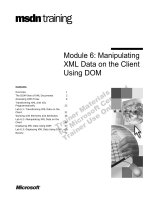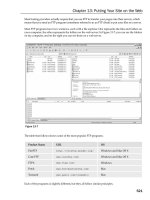Tài liệu Voice over IP Open-Source Platforms and the Session Initiation Protocol doc
Bạn đang xem bản rút gọn của tài liệu. Xem và tải ngay bản đầy đủ của tài liệu tại đây (255.04 KB, 21 trang )
Geek-Speak Glossary:
A Manager’s Guide to
IT Terminology
1-800-COURSES
www.globalknowledge.com
Expert Reference Series of White Papers
Introduction
The rapidly changing pace of information technology leads to acronyms and terms being created and used
seemingly overnight. This glossary is a guide to the most commonly used and confused IT terms designed to
help managers better communicate with (and understand) their IT staff.
Glossary of Terms
10Base5 (10 Mbps, baseband, 500 meter): one of several physical media specified by 802.3 for use in an
Ethernet local area network LAN); consists of
Thickwire coaxial cable with a maximum segment length of 500
meters
10Base2 (10 Mbps,
baseband, 185 meter):
one of several physical media specified by IEEE 802.3 for use
in an Ethernet local area network LAN); consists of Thickwire coaxial cable with a maximum segment length of
185 meters
10BaseT (10 Mbps, baseband, unshielded twisted-pair): one of several physical media specified by
IEEE 802.3 for use in an Ethernet local area network (LAN); is ordinary telephone twisted pair wire
100BaseT (100 Mbps, baseband, unshielded twisted-pair): one of several physical media specified by
IEEE 802.3 for use in an Ethernet local area network (LAN); referred to as Fast Ethernet because of its higher
transmission speed
AAL (ATM adaptation layer): adapts PDUs passed down from higher layers onto ATM cells
Active hub: allows multiple devices to be wired to a central location to share the same media and regener-
ate the signal;
also referred to as multiport repeaters
ADSL (asymmetric digital subscriber line): typical form of xDSL telephone companies offer to residences
AGP (accelerated or advanced graphics port): a high-speed, point-to-point channel for attaching a
graphics card to a computer’s motherboard, primarily to assist in the acceleration of 3D computer graphics
ALU (arithmetic logic unit): a digital circuit that calculates an arithmetic operation (e.g., addition, subtrac-
tion) and logic operations between two numbers; the fundamental building block of the Central Processing
Unit (CPU) or a computer
Geek-Speak Glossary: A Manager’s
Guide to IT Terminology
Copyright ©2007 Global Knowledge T
raining LLC. All rights reserved.
Page 2
A
M (amplitude modulation):
a
technique used for transmitting information via a radio carrier wave
Amplitude: height of the wave at any point in the wave
ANSI (American National Standards Institute): a voluntary organization that coordinates the develop-
ment and use of consensus standards in the United States and represents the needs and views of U.S.
stakeholders in standardization forums around the globe
API (application programming interface): gives programmers a formal set of routines to call on to use
underlying network services
Application layer: performs the functions of file transfer, e-mail, etc. (see OSI Model)
Architecture: how a system is designed; includes how the components are connected to and operate with
each other
ARP (address resolution protocol): network layer protocol provided with TCP/IP; used to map an IP (inter-
net protocol) address to a MAC (media access card) address
ASCII (American Standard Code for Information Interchange): relates a number from 0 to 255 in the
binary (base 2) form to keyboard characters
ASIC (application-specific integrated circuit): an integrated circuit designed for a particular use (e.g., a
chip designed solely to run a cell phone)
Asynchronous communication: describes when devices, such as computers, rely on their own internal
clocks; it provides connectivity to printers
, modems, fax machines, etc.
ATM (asynchronous transfer mode): high bandwidth, cell-switching technology; designed to carry many
different types of information, including voice, video, image, data, and graphics; another form of STDM (statis-
tical time division multiplexing)
AUI (attachment unit interface): a 15-pin connection that provides a path between a node’s Ethernet
interface and the medium attachment unit (MAU); also known as a transceiver
AS (Autonomous system): collection of IP networks under the control of a single entity
B (bearer) channel: carries voice, video, image, or data traffic, depending upon the equipment and applica-
tions available
Bandwidth: expressed in a range of frequencies using hertz as the unit of measurement;
also called analog
capacity
Base 2 System: binary number system, only two discrete values (0 and 1) are possible and all numbers are a
combination of these two characters; digital signals are numbers sent in the Base 2 system
Base 10 System: the decimal system
Copyright ©2007 Global Knowledge T
raining LLC. All rights reserved.
Page 3
B
aseband:
d
escribes signals and systems whose range of frequency is measured from 0 to a maximum band-
width or highest signal frequency; sometimes used as a noun for a band of frequencies starting at 0
BGP (border gateway protocol): an interautonomous system routing protocol; a network or group of net-
works under a common administration and with common routing policies
Bit: contraction of the expression “binary digit”; smallest unit of data in a computer
BIOS (basic input/output system): the firmware code run by an IBM-compatible PC when first powered
on, known as “booting up”; primary function is to prepare the machine so other software programs can load,
execute, and assume control of the PC
Bluetooth: specification that allows mobile phones, computers, and PDAs to be connected wirelessly over
short ranges
Bps: bits per second:
common measure of data speed for computer modems and transmission carriers
BRI (basic rate interface): an integrated services digital network configuration, usually intended for the
home and small enterprise (see also PRI)
Bricks and clicks: business that existed pre-Internet that now uses e-commerce technology to sell on the
Internet
Bridge: interprets the LAN hardware adapter address contained in MAC and decide whether to filter or for-
ward the frame; does not change the frame in any way
Browser
s:
client applications that access WWW servers
Building backbone: connects LANs within a building
Bus: electrical connection between any two components in a computer
Bus topology: system layout where electrical signals generated by a device connected anywhere on the bus
are received by all other connected devices
Byte: the standard size of data in a computer;
8-bits
Cache: keeps data the processor is likely to need quickly close at hand; increases processor operation speed
CAD/CAM (computer
-aided design/computer
-aided manufacturing):
softw
are used to design prod
-
ucts such as electronic circuit boards in computers
Campus backbone: connects building LANs together
CAP (competitive access provider): company that provides network links between the customer and the
IntereXchange carrier or directly to the internet service provider (ISP);
CAPs operate priv
ate networks inde
-
pendent of local exchange carriers
Copyright ©2007 Global Knowledge T
raining LLC. All rights reserved.
Page 4
C
D-R (compact disc - recordable):
s
pecial type of CD-ROM that can be written onto by any computer with
a recording drive; can only be written onto once
CD-ROM (compact disc read-only memory): optical storage device read by lasers; can hold up to 700
megabytes of data
CD-RW (compact disc - rewritable): special type of CD-ROM that can be written onto by any computer
with a recording drive; can be written onto more than once
Checksum: a count of the number of bits in a transmission unit that is included with the unit so the receiver
can check to see whether the same number of bits arrived
CIR (committed information rate): describes the user information transfer rate the network supports dur-
ing normal network operations
CLEC (competitive local e
xchange carrier):
In the US
, a telecommunications provider company (also
called a carrier) that competes with other, already established carriers (the local telephone company; e.g., GTE,
Bell South).
CLI (command line interface): allows precise control of a function, but requires remembering all the cor-
rect commands and switches necessary for a task; used in DOS; a way of interacting with computers
Client/server architecture: network where some computers are dedicated clients (workstations) and some
are dedicated servers; information is centralized on the server, and an administrator sets policies and manages
it
CMOS (complementary metal-oxide semiconductor) RAM: requires very little power; maintains infor
-
mation even when the computer is off
Collision: occurs when several network users communicate at the same time and interfere (collide) with one
another
Collision domain: logical network segment where data packets can "collide" with one another for being
sent on a shared medium, in particular in the Ethernet networking protocol
Computer networking: a combination of hardw
are and software that lets the various computers in an
organization communicate with one another
Computer operating system (OS): special computer program that provides an environment in which
other programs can use the computer’
s central processor and the attached input/output devices
Connectivity devices: bring users of the network into contact with one another
Constant bit rate (CBR): transmission that uses a set amount of network capacity on a continual basis;
used when the arrival of the information is time-sensitive
Convergence: the merging and sometimes clashing of voice and data networks
Copyright ©2007 Global Knowledge T
raining LLC. All rights reserved.
Page 5
CPE (customer premises equipment): generally refers to telephones, DSL or cable modems, or purchased
set-top boxes for use with communication service providers’ services
CPS (cycles per second): measure of how frequently an alternating current changes direction; has been
replaced by the term hertz (Hz)
CPU (Central Processing Unit): the brain of the computer system where calculations and decisions are
made; also referred to as the processor
CPU Speed: how fast the CPU works
CSU (channel service unit): provides a loopback function for telephone company testing, and checks bipo-
lar signal generation
CRC (cyclic redundancy check): method of checking for errors in data that has been transmitted on a com-
munications link; a function used to produce a Checksum against a block of data
CS (convergence sublayer): particular protocols that are responsible for gathering and formatting higher
layer information so it can be processed by the lower layers
CSMA/CD (carrier sense multiple access/collision detect): set of rules for determining how network
devices response when two devices collide
D (data) channel: used for common channel signaling by both the telephone company switch and the cus-
tomer equipment; provides the call signals that set up B channel connections
DACS (digital access and cross-connect system): a piece of telecommunications equipment used for
routing T1 lines; can cross-connect any T1 line in the system with any other T1 line in the system
Data: information manipulated inside the computer in the form of bits and bytes
Datagram: data packet that is sent over an IP network; associated with the network layer when communica-
tion protocol is connectionless
DCE (data communications equipment OR data cir
cuit-terminating equipment):
a device that
communicates with a data terminal equipment (DTE) device in a particular standard
DDP (datagram delivery protocol): a member of the AppleTalk networking protocol suite, mainly respon-
sible for socket-to-socket delivery of datagrams over an AppleTalk network
DE (discar
d eligibility):
signal used to identify less important data traffic that can be dropped during peri
-
ods of congestion on the system
DLCI (data link connection identifier): a channel number that tells the network how to route the data
Copyright ©2007 Global Knowledge T
raining LLC. All rights reserved.
Page 6
D
MA (direct memory access):
a
feature that allows certain hardware subsystems in a computer to access
system memory for reading and/or writing independently of the CPU; can include disk drive controllers, graph-
ics cards, network cards, and sound cards
DOS (disk operating system): a family of closely related operating systems (COS) that ran on IBM PC-type
hardware.
DNA (digital network architecture): a set of specifications or protocols created by Digital Equipment
Corporation (DECnet) that evolved into one of the first peer-to-peer network architectures
DNS (domain name system): service that connects a domain name to an IP address
DRAM (dynamic random access memory): primary choice for holding large amounts of information due
to its inexpensive cost; must be refreshed or rewritten frequently (about every 386 milliseconds)
DS0 (digital signal,
level 0):
basic digital signaling rate of 64 kbit/s
, corresponding to the capacity of one
voice-frequency-equivalent channel
DS1 (digital signal,
level 1):
also known as
T1; widely used to transmit voice and data between devices
DSL (digital subscriber line): technology that delivers digital data transmission over the wires of a local
telephone network
DSU (data service unit): transforms digital signal from a unipolar DTE to a bipolar digital network signal on
the transmitting side and vice versa on the receiving side
DTE (data terminal equipment): a device that performs functions at the network end of a communica-
tions line; see DCE (data communications equipment).
DVD (digital versatile disc): can hold over seven times as much information as CDs; drives are backward-
compatible with CD-ROM drives
DWDM (dense wavelength-division multiplexing): an optical technology used to increase bandwidth
over existing fiber optic backbones (see building backbone, campus backbone)
EBCDIC (e
xtended binary coded decimal interchange code):
8-bit character encoding table used by
ISM mainframes
EGP (exterior gateway protocol): a protocol commonly used between hosts on the Internet to exchange
routing table information
EMI (electromagnetic interference): radiation that causes unwanted signals (interference or noise) to be
induced in other circuits; also called radio frequency interference or RFI
Enterprise network: connects many types of networks
Copyright ©2007 Global Knowledge T
raining LLC. All rights reserved.
Page 7
E
thernet:
m
ost commonly used protocol designed to change the packets into electrical signals that can be
sent out over the wire
Exterior protocols: routing protocol used between autonomous systems
FAT (file allocation table): table that the operating system uses to locate files on a disk; because a file may
be divided into many sections that are scattered around the disk, the FAT keeps track of all the pieces
FDDI (fiber distributed data interface): a set of ANSI protocols for sending digital data over fiber optic
cable (see ANSI)
FDM (frequency-division multiplexing): permits a range of input signals to be carried over a communi-
cation line that uses separate carrier frequencies for each signal channel; mostly used for analog information
but can carry digital
File management system: w
ay to store and retrieve information from disk drives; controls how files can be
created, accessed, retrieved, and deleted
Fir
ewall:
a barrier between a network and the Internet through which only authorized users can pass;
set of
security policies to screen incoming and outgoing messages; also used to isolate one part of a network from
another
Floppy drive: early versions were actually floppy; today, they use hard 3.5 inch disk; also referred to as
removable drive
FM (frequency modulation): blending data into a carrier signal; a modem modulates data by converting it
to audible tones that can be transmitted on a telephone wire, and demodulates received signals to get the
data
Frame: data structure that collectively represents the transmission stream (headers, data, and the trailer) and
provides the information necessary for the correct delivery of the data
Frame relay: service with standards and specifications designed to transmit data; some users have had suc-
cess at transmitting voice
FRAD (fr
ame relay access device):
softw
are that frames the customer’s payload with the Frame Relay
overhead information, including the first DLCI (data link connection identifier) address, to prepare it for deliv-
ery to the network
Fr
equency:
number of times a w
ave repeats a cycle in a one-second period;
measured in cycles per second,
or hertz
FTP (file transfer protocol): application used to transfer a copy of a file from one computer to another
computer with one acting as client and the other as server; a login with a user name and password is typically
required
Copyright ©2007 Global Knowledge T
raining LLC. All rights reserved.
Page 8









